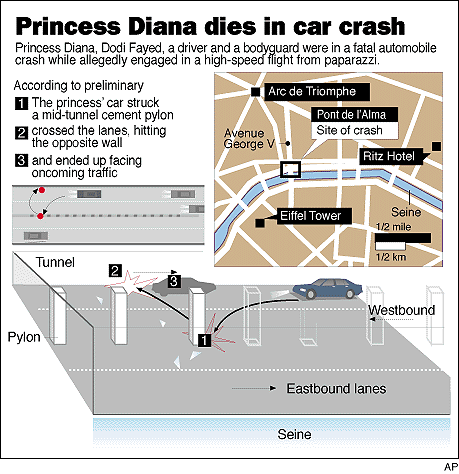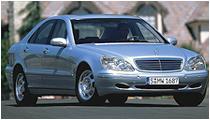Junk mail - Globalisation
An English princess with an Egyptian boyfriend crashes in a French
tunnel driving a German car with a Dutch engine, driven by a Belgian driver,
who was high on Scottish whiskey, followed closely by Italian Papparazi,treated
by an American doctor, using Brazilian medicines, dies!”
From P_____ - Hey, i didn't know Mercedes engines were made even
in Holland.... and ( Here i go again, blabbering about cars..) IF that
princess had fastened her seat belt, the Japanese Multiple pneumatic airbags(
a toyota Invention) would have protected her form all sides. As the car
was doing 90mph, ( that's 145 kph for us Indians !) she could have opened
the australian anti-jam doors( these come from mazda, australia) herself
and perhaps even walked away. That is how safe a mercedes is..... but only
when you're on the correct side of your seat-belt.
The above was a mail I recently received. Being rather amused and saddened by the gross inaccuracies in it I just thought I'd clear them up.
Well, if you want to be a stickler for detail: -
Henri Paul, the driver, was definitely not Belgian (whoever dreamt
of that?). He was born on 3 July 1956 in Lorient, Southern Brittany, France
and his nationality was very much French.
Frederic Mailliez, the doctor who first treated her, was by no means
American either. On the contrary, he is a French physician.
Bruno Riou(also not American, surprise!) is head of the intensive care
unit at Pitie-Salpetriere and took charge of Diana's medical treatment.
Early reports from the hospital indicate that Princess Diana went into
arrest after arrival and that doctors did not discover the internal hemorrhage
of Diana's left pulmonary vein until after her chest was opened. "On her
arrival at the hospital, Diana was bleeding profusely in the chest area,"
Riou said. Cardiac arrest quickly set in. Doctors opened the princess'
chest cavity and discovered "an important wound of the left pulmonary vein,"
he said. The wound, the apparent source of the hemorrhage, was closed,
and heart massage - external, then internal - was applied for two hours.
But it failed to revive her, and she was declared dead at 4 a.m. local
time."
Brazilian medicines? I don't think so.
Paprazzi is a word of Italian origin but as for the reporters and photographers
themselves - Nikola Arsov, of the Sipa agency; Jacques Langevin, of the
Sygma agency; Laslo Veres, a freelance, Stephane Darmon, of the Gamma agency;
and Serge Arnal of the Stills agency; Romuald Rat, of Gamma, and Christian
Martinez, of the Angeli agency one cannot really say the same. Six are
Frenchmen and one Macedonian.
The details of all the people involved(nine photographers and
one photo-agency motorcycle driver) are :-
1) ARNAL Serge
 D.O.B.
10th August 1961 in PARIS 12th district
D.O.B.
10th August 1961 in PARIS 12th district
2) ARSOV Nikola
D.O.B. 20th April 1959 in SKOPJE (Yugoslavia)
3) DARMON Stéphane
D.O.B. 27th May 1965 in PARIS 1st district
4) LANGEVIN Jacques
D.O.B. 21st September 1953 in LAVAL (MAYENNE)
5) MARTINEZ Christian
D.O.B. 15th May 1954 in PARIS 12th district
6) RAT Romuald
D.O.B. 17th September 1971 in LE RAINCY (SEINE SAINT DENIS)
7) VERES Laslo
D.O.B. 1st December 1943 in BECEJ (Yugoslavia)
8) ODEKERKEN David
D.O.B. 8th March 1971 in CRETEUIL (94)
9) CHASSERY Fabrice
D.O.B. 16th March 1967 in PARIS 12th district
10) BENAMOU Serge
D.O.B. 15th September 1953 in SAIDA (Algeria)
Technically, though Dodi al Fayed was born in Egypt, his father Mohamad
al Fayed has lived in England for 20 years, and all four of al Fayed's
children by his second wife are British citizens. Mohamad al Fayed himself
could not achieve his goal to become a British citizen. The Fayed brothers'
applications for citizenship stalled in the early '90s though they have
paid millions of pounds in taxes annually.
Scotch?
Paul apparently drank his first alcohol that Saturday at a bar in the
Ritz Hotel after he and Dourneau(Fayed's regular chauffeur, Philippe Dourneau)
took the couple there at 4 p.m. Several hotel employees said that Paul
drank a couple of glasses of Ricard pastis, a French liqueur about as potent
as whiskey.
Hotel security cameras showed Paul arriving back at the Ritz at 10:08
p.m. A French newspaper quoted employees at a hotel bar saying Paul drank
more pastis while waiting on Fayed and Diana, who were having dinner. Pastis
was Marseille slang for anis drinks mixed with water. Pastis comes from
the Italian "pasticcio", which means trouble, as in troubled water. When
one mixes anis with four measures of water, the result is a opaque drink,
a troubled water. Hence the name pastis.
When the anti-anis law was abolished Paul Ricard commercialized his
product with the slogan: "Ricard, the true pastis from Marseille!". Paul
Ricard was a travelling salesman, peddling pub articles to cafés
all over France in the 30s.
Obviously then we cannot refer to Ricard pastis as Scottish whiskey.
So, what did Henri Paul have to drink the night of the accident?
Four WallBangers and seven chasers.
What, you may ask, is a
?
It is drink that would no doubt do a Shaker proud (if only they drank)
thanks to its simplicity.
First, you make a Screwdriver (1/4 to 1/3 vodka -- any plain vodka
-- with the rest orange juice, stirred up and over ice).
The Harvey Wallbanger secret?
Add to that a splash of Galliano, leaving it floating on the top.
Did somebody say Scotch?
Vodka is very much Russian. Galliano is that funny yellow Italian stuff
that is often made in France and always comes in a tall, weird, angular
bottle. Back in the 70's, they used to make giant bottles with a metal
valve in the bottom. People used to covet these things to keep their loose
change in. Orange juice and ice? Well, need I say more?
The car in question was reported as having been a Mercedes-Benz 600-series
sedan, which is the top-of-the-line, twelve-cylinder, S-Class model. S-280
to be precise. 
 As for Princess
Di being able to 'walk away', the auto companies and the various governmental
safety monitoring bodies crash test cars into flat barriers, sometimes
offset slightly in one direction or another. No one, designs or tests cars
to withstand high-speed collisions with pillars, as was the case with the
crash in question here. Wolfgang Inhester, Mercedes-Benz's vice-president
of passenger car press relations, issued a statement in which he noted,
"This was an accident of such a dimension that any type of safety standards
within the car would not have given the passengers a real chance..."
As for Princess
Di being able to 'walk away', the auto companies and the various governmental
safety monitoring bodies crash test cars into flat barriers, sometimes
offset slightly in one direction or another. No one, designs or tests cars
to withstand high-speed collisions with pillars, as was the case with the
crash in question here. Wolfgang Inhester, Mercedes-Benz's vice-president
of passenger car press relations, issued a statement in which he noted,
"This was an accident of such a dimension that any type of safety standards
within the car would not have given the passengers a real chance..."
Now for the "Japanese Multiple pneumatic airbags(a toyota Invention)"
In 1952, after witnessing the speed at which a Navy torpedo canvas
could be filled by compressed air, John Hetrick was granted the first patent
for what would become the predecessor to the airbag. Despite the airbag's
obvious utility, it would take nearly two decades for automakers to become
convinced of their importance. 
Through a series of crash tests, engineers and safety experts determined
what was needed to make the airbag a successful safety feature.
In 1970, the newly founded NHSTA, alarmed by the fact that fewer than
15 percent of all Americans wore seatbelts, began to look for new ways
to protect accident victims. Hetrick's airbag concept was seen by many
as the ultimate passive restraint, even though manufacturing safe airbags
would clearly be an enormous challenge. Engineers had to determine how
big the bag should be, what materials should be used in it, and how to
inflate it within 30 milliseconds after impact without blowing it apart.
These challenges were met, however, and by 1980, Mercedes began offering
airbags as standard equipment. Eight years later, all U.S. car manufacturers
were required to follow suit.
Conclusion - There's a lot of junk floating around there.
Don't believe everything every bozo mails you, cuz there's always someone
out there with the eptitude(opposite of ineptitude?) and sheer excess of
time to prove it wrong.
 D.O.B.
10th August 1961 in PARIS 12th district
D.O.B.
10th August 1961 in PARIS 12th district

 As for Princess
Di being able to 'walk away', the auto companies and the various governmental
safety monitoring bodies crash test cars into flat barriers, sometimes
offset slightly in one direction or another. No one, designs or tests cars
to withstand high-speed collisions with pillars, as was the case with the
crash in question here. Wolfgang Inhester, Mercedes-Benz's vice-president
of passenger car press relations, issued a statement in which he noted,
"This was an accident of such a dimension that any type of safety standards
within the car would not have given the passengers a real chance..."
As for Princess
Di being able to 'walk away', the auto companies and the various governmental
safety monitoring bodies crash test cars into flat barriers, sometimes
offset slightly in one direction or another. No one, designs or tests cars
to withstand high-speed collisions with pillars, as was the case with the
crash in question here. Wolfgang Inhester, Mercedes-Benz's vice-president
of passenger car press relations, issued a statement in which he noted,
"This was an accident of such a dimension that any type of safety standards
within the car would not have given the passengers a real chance..."
